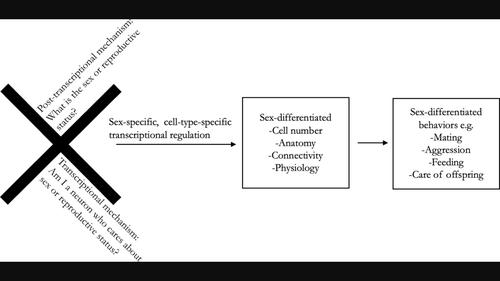当前位置:
X-MOL 学术
›
WIREs Mech. Dis.
›
论文详情
Our official English website, www.x-mol.net, welcomes your feedback! (Note: you will need to create a separate account there.)
Let's talk about sex: Mechanisms of neural sexual differentiation in Bilateria
WIREs Mechanisms of Disease ( IF 3.1 ) Pub Date : 2024-01-07 , DOI: 10.1002/wsbm.1636 Emma C. Roggenbuck 1 , Elijah A. Hall 1 , Isabel B. Hanson 1 , Alyssa A. Roby 1 , Katherine K. Zhang 1 , Kyle A. Alkatib 1 , Joseph A. Carter 1, 2 , Jarred E. Clewner 1 , Anna L. Gelfius 1 , Shiyuan Gong 1 , Finley R. Gordon 1, 2 , Jolene N. Iseler 1 , Samhita Kotapati 1 , Marilyn Li 1 , Areeba Maysun 1 , Elise O. McCormick 1 , Geetanjali Rastogi 1 , Srijani Sengupta 1 , Chantal U. Uzoma 1 , Madison A. Wolkov 1 , E. Josephine Clowney 2, 3
WIREs Mechanisms of Disease ( IF 3.1 ) Pub Date : 2024-01-07 , DOI: 10.1002/wsbm.1636 Emma C. Roggenbuck 1 , Elijah A. Hall 1 , Isabel B. Hanson 1 , Alyssa A. Roby 1 , Katherine K. Zhang 1 , Kyle A. Alkatib 1 , Joseph A. Carter 1, 2 , Jarred E. Clewner 1 , Anna L. Gelfius 1 , Shiyuan Gong 1 , Finley R. Gordon 1, 2 , Jolene N. Iseler 1 , Samhita Kotapati 1 , Marilyn Li 1 , Areeba Maysun 1 , Elise O. McCormick 1 , Geetanjali Rastogi 1 , Srijani Sengupta 1 , Chantal U. Uzoma 1 , Madison A. Wolkov 1 , E. Josephine Clowney 2, 3
Affiliation

|
In multicellular organisms, sexed gonads have evolved that facilitate release of sperm versus eggs, and bilaterian animals purposefully combine their gametes via mating behaviors. Distinct neural circuits have evolved that control these physically different mating events for animals producing eggs from ovaries versus sperm from testis. In this review, we will describe the developmental mechanisms that sexually differentiate neural circuits across three major clades of bilaterian animals–Ecdysozoa, Deuterosomia, and Lophotrochozoa. While many of the mechanisms inducing somatic and neuronal sex differentiation across these diverse organisms are clade-specific rather than evolutionarily conserved, we develop a common framework for considering the developmental logic of these events and the types of neuronal differences that produce sex-differentiated behaviors.
中文翻译:

让我们来谈谈性别:两侧对称动物的神经性别分化机制
在多细胞生物中,有性腺已经进化出有利于精子与卵子的释放,两侧对称动物通过交配行为有目的地结合它们的配子。不同的神经回路已经进化出来,控制着从卵巢产生卵子和从睾丸产生精子的动物的这些物理上不同的交配事件。在这篇综述中,我们将描述两侧对称动物的三个主要分支(蜕皮动物、后生动物和冠轮动物)神经回路性别差异的发育机制。虽然在这些不同的生物体中诱导体细胞和神经元性别分化的许多机制是进化枝特异性的,而不是进化上保守的,但我们开发了一个共同的框架来考虑这些事件的发育逻辑以及产生性别分化行为的神经元差异的类型。
更新日期:2024-01-07
中文翻译:

让我们来谈谈性别:两侧对称动物的神经性别分化机制
在多细胞生物中,有性腺已经进化出有利于精子与卵子的释放,两侧对称动物通过交配行为有目的地结合它们的配子。不同的神经回路已经进化出来,控制着从卵巢产生卵子和从睾丸产生精子的动物的这些物理上不同的交配事件。在这篇综述中,我们将描述两侧对称动物的三个主要分支(蜕皮动物、后生动物和冠轮动物)神经回路性别差异的发育机制。虽然在这些不同的生物体中诱导体细胞和神经元性别分化的许多机制是进化枝特异性的,而不是进化上保守的,但我们开发了一个共同的框架来考虑这些事件的发育逻辑以及产生性别分化行为的神经元差异的类型。



























 京公网安备 11010802027423号
京公网安备 11010802027423号